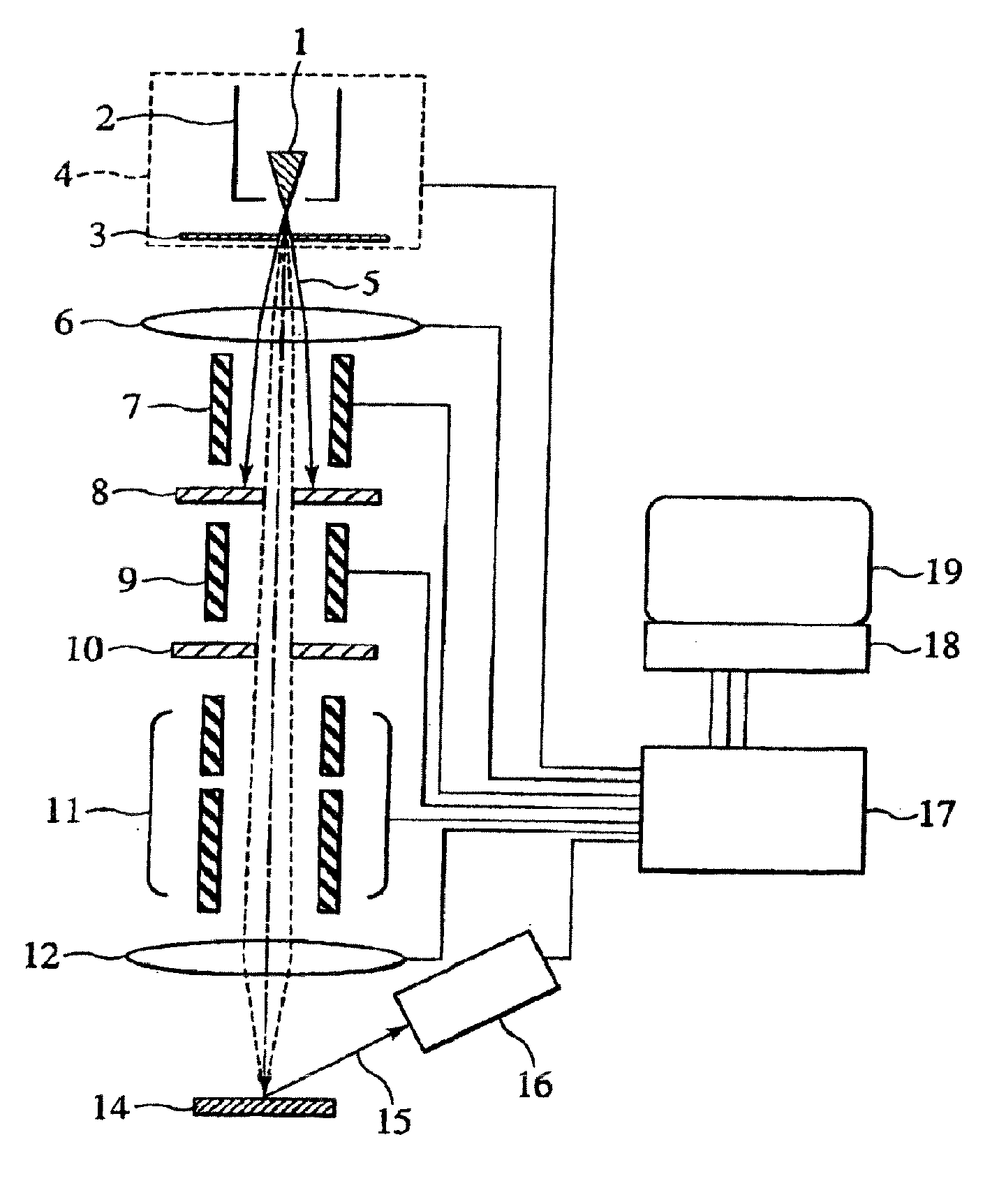Gas field ionization ion source, scanning charged particle microscope, optical axis adjustment method and specimen observation method
a charge particle microscope and ionization ion source technology, applied in the field of charge particle microscopes, to achieve the effects of reducing the diameter of the aperture, reducing the physical vibration of the cooling means, and high-quality gfis
- Summary
- Abstract
- Description
- Claims
- Application Information
AI Technical Summary
Benefits of technology
Problems solved by technology
Method used
Image
Examples
embodiment 1
[0040]FIG. 1 schematically shows the construction of a scanning charged particle microscope equipped with a GFIS. The ions 5 emitted from the emitter 1 of the GFIS 4 are focused onto a specimen 14 by a focusing lens 6 and an objective lens 12. A beam deflector / aligner 7, a movable beam limiting aperture plate 8, a blanking electrode 9, a blank beam stop plate 10 and a beam deflector 11 are disposed between the two lenses. The secondary electrons 15 emitted from the specimen 14 are detected by a secondary electron detector 16. A beam controller 17 controls the GFIS 4, focusing lens 6, objective lens 12, upper beam deflector / aligner 7, lower beam deflector 11, secondary electron detector 16 and others. A personal computer 18 controls the beam controller 17 and processes / stores various data. An image display unit 19 displays SIM images and control screens of the PC 18.
[0041]FIG. 2A is a diagram for explaining the relation between the emitter's tip and the hole diameter of the extractio...
embodiment 2
[0047]The present embodiment described below is a scanning charged particle microscope provided with changing means to change the aperture diameter dapture of the extraction electrode 3 which differs from the changing means employed in embodiment 1. The following description is focused on what are unique to the present embodiment.
[0048]The changing means of the present embodiment is structurally similar to the variable aperture employed in cameras and others. Plural diaphragm blades are combined so as to have a circular aperture which can coaxially be varied in diameter by changing the amount of overlap between diaphragm blades. By employing such means to change the aperture diameter of the extraction electrode, it is possible to not only let widely emitted ions go through but also, in behalf of differential pumping, reduce the diameter of the aperture.
embodiment 3
[0049]The present embodiment is a scanning charged particle microscope provided with changing means to change the aperture diameter daperture of the extraction electrode 3 which differs from the changing means employed in either embodiment 1 or 2. The following description is focused on what are unique to the present embodiment.
[0050]As shown in FIG. 4, the changing means of the present embodiment can be separated into an aperture-forming part 3d having an aperture through which ions extracted by the extraction electrode are passed, and a mounting part 3c on which the aperture-forming part 3d is mounted. The aperture-forming part 3d can be moved to and withdrawn from the optical axis 20. The aperture-forming part 3 is located as indicated with reference numeral 3d′ if the aperture-forming part 3 is withdrawn from the optical axis 20 by sliding it on the mounting part 3c.
PUM
 Login to View More
Login to View More Abstract
Description
Claims
Application Information
 Login to View More
Login to View More - R&D
- Intellectual Property
- Life Sciences
- Materials
- Tech Scout
- Unparalleled Data Quality
- Higher Quality Content
- 60% Fewer Hallucinations
Browse by: Latest US Patents, China's latest patents, Technical Efficacy Thesaurus, Application Domain, Technology Topic, Popular Technical Reports.
© 2025 PatSnap. All rights reserved.Legal|Privacy policy|Modern Slavery Act Transparency Statement|Sitemap|About US| Contact US: help@patsnap.com



